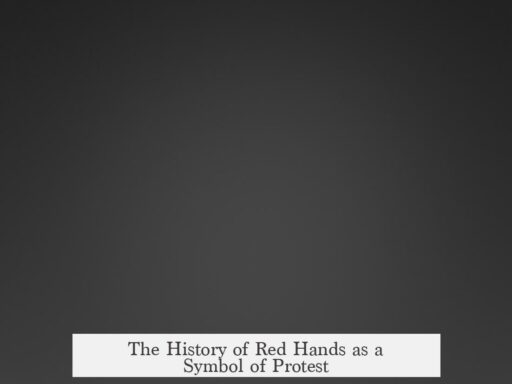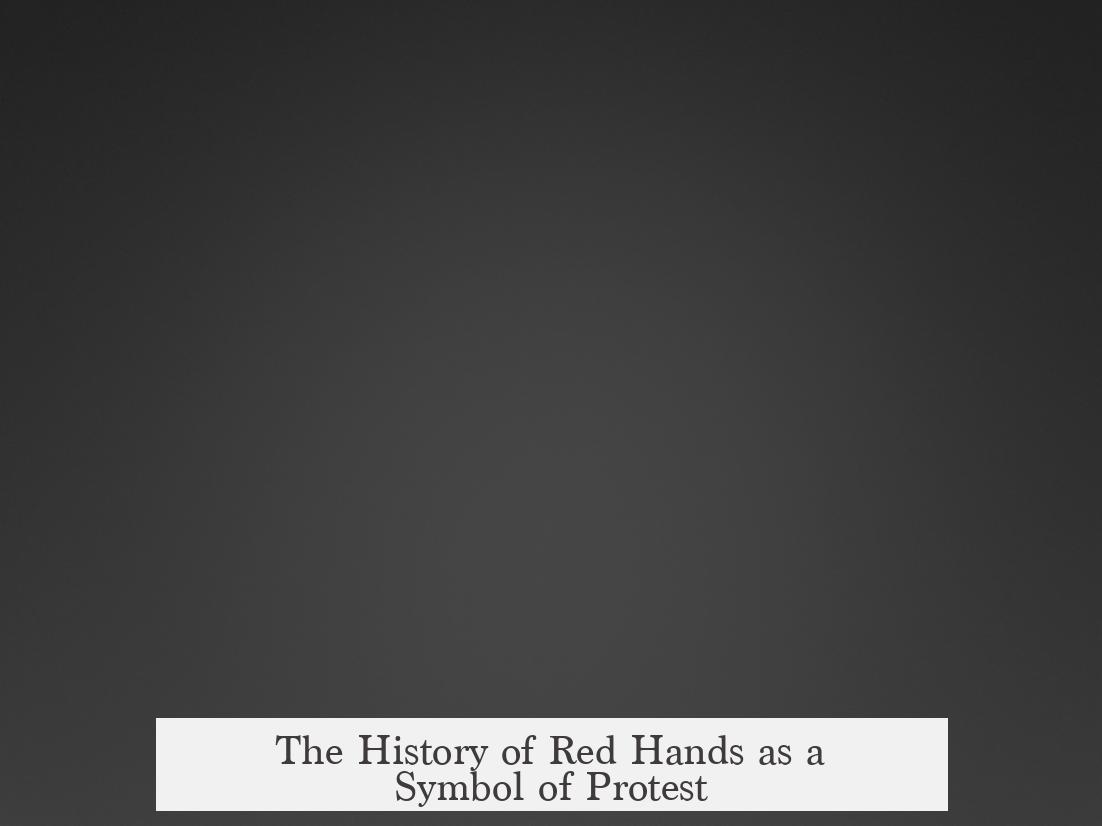The history of red or bloody hands and handprints as a protest symbol spans various cultures, events, and meanings. It does not originate from a single source. Instead, red hands have been used metaphorically and visually in several distinct contexts, carrying different messages from solidarity to accusations of responsibility for violence.
Historically, the “Red Hand” is known outside protest circles for its use as a heraldic symbol, such as the Red Hand of Ulster in Irish tradition. This emblem dates back hundreds of years but is not typically considered a protest symbol or associated with modern activism. Likewise, the metaphor “blood on one’s hands” has long existed in literature and speech as a metaphor for guilt or culpability. Macbeth’s lament about Neptune’s ocean washing blood from his hands is an early example, indicating the strong symbolic importance of bloodied hands as signs of wrongdoing or crime. However, physical displays of red handprints or bloody hands as direct protest images are a much more recent development.
Since the late 20th century and especially in the last 20 years, red handprints have emerged as potent protest and solidarity symbols in social justice movements. For instance, Indigenous rights activists in the U.S. and Canada widely use red handprints painted across their mouths or as prints on banners to represent the epidemic of violence against Indigenous women. These women face disproportionately high rates of sexual violence and murder compared to other populations. The red handprint here acts as a deeply evocative emblem of silenced victims and a call for justice.
Another prominent use comes from the international campaign to end the use of child soldiers. Since 1998, groups like Human Rights Watch have promoted “Red Hand Day” annually on February 12, marking the date the Optional Protocol to the Convention on the Rights of the Child on armed conflict came into force (2002). Activists wear red handprints or display them to symbolize opposition to the exploitation of children in warfare worldwide.
In the context of the Israeli-Palestinian conflict, the red hand symbol gained a particularly charged and controversial meaning during the Second Intifada. On October 12, 2000, two Israeli reservist soldiers accidentally entered Ramallah and were detained by Palestinian Authority police. A mob outside the police station violently killed the soldiers, culminating in the infamous photo showing one Palestinian, Aziz Salha, holding up bloodied hands to the crowd. This grisly image became a symbol of brutality and sectarian violence. For many Israelis and Jews, red or bloody hands evoke this traumatic event and symbolize the perceived savagery and hatred witnessed during the conflict. Consequently, the use of red hands in pro-Palestinian protests or activism can be interpreted as deeply emotional and politically loaded, provoking strong reactions and disagreement.
One modern symbol that brought this history into contemporary public discussion is the “Artists4Ceasefire” red hand pin. Worn by celebrities at the 2024 Oscars, the pin features a red hand with a black heart and represents solidarity for a Gaza ceasefire, hostage release, and humanitarian aid. Many protesters adopting red hands see it as a universal call to stop violence. However, some in Jewish communities interpret the pin as echoing the Ramallah lynching imagery, linking it to antisemitism and historical trauma. Critics argue it symbolizes Jewish suffering, while defenders say it is a purely humanitarian emblem. This debate highlights how red hands carry different meanings shaped by collective memory and identity.
Red hands also serve as a general protest sign for “stop.” Some theorists link the symbol to the Red Hand of Ulster or Palestinian nationalist claims, but evidence is limited. Moreover, Israeli citizens have used bloody hands in protests themselves, such as demonstrations against their government after recent attacks, showing the symbol’s varied applications.
| Use Context | Meaning | Notable Examples |
|---|---|---|
| Red Hand of Ulster | Historical emblem, not protest | Irish symbol of kinship and land claims |
| Indigenous Women’s Rights | Symbolize violence and silencing | Red handprints over mouth or signs |
| Child Soldiers Campaign (Red Hand Day) | Opposition to child soldier recruitment | Human Rights Watch campaigns |
| Second Intifada (Ramallah Incident) | Symbol of brutality and conflict emotions | Photo of Aziz Salha’s bloody hands |
| Artists4Ceasefire Pin | Call for Gaza ceasefire and humanitarian aid | Worn at 2024 Oscars; controversy over symbolism |
| General Protest Symbol | Universal “stop” gesture | Used in various social justice protests globally |
The red or bloody hand as a protest symbol carries multiple meanings. It can represent guilt, violence, stopping oppression, solidarity with victims, or a call for peace. Its interpretation depends heavily on the cultural and political context. The Ramallah lynching in 2000 gave red hands a particularly intense significance in Israeli-Palestinian discourse, while Indigenous and child rights movements have adopted the symbol for awareness campaigns worldwide. Contemporary uses, like the Artists4Ceasefire pin, show how red hands remain a dynamic and sometimes divisive emblem in global activism.
- Red or bloody hands lack a single origin as protest symbols but appear in many contexts.
- Historically, some instances like the Red Hand of Ulster are not protest-related.
- Modern uses include solidarity for Indigenous women and anti-child soldier efforts.
- The 2000 Ramallah lynching created a highly charged symbol with lasting impact.
- Artists4Ceasefire pins show the symbol’s evolving use and associated controversies.
- Red hands also serve as a universal “stop” sign in protests worldwide.
What is the earliest known use of red hands as a symbol?
The Red Hand of Ulster is a historic symbol dating back centuries. However, it was not originally used as a protest symbol but more as a regional emblem.
How did red handprints become linked to Indigenous women’s rights?
In the last 20 years, red handprints have symbolized solidarity with Indigenous women in the U.S. and Canada. The red marks raise awareness about violence against Indigenous women, who face high rates of assault and murder.
Why do human rights groups use red hands in campaigns against child soldiers?
Since 1998, groups like Human Rights Watch use red hands to protest the use of child soldiers. Red Hand Day, observed since 2002, marks efforts to stop children in armed conflict.
What is the significance of red hands in the 2000 Ramallah incident?
The bloody hands originated when a Palestinian man displayed his bloodied hands after the lynching of two Israeli soldiers. This image became a lasting, powerful symbol of the Second Intifada.
Why do red hand symbols provoke strong emotions in Israeli-Palestinian contexts?
Because the symbol recalls a violent, traumatic event from the Second Intifada, it carries heavy emotional and political weight. Different groups interpret the symbol in conflicting ways linked to their histories.




